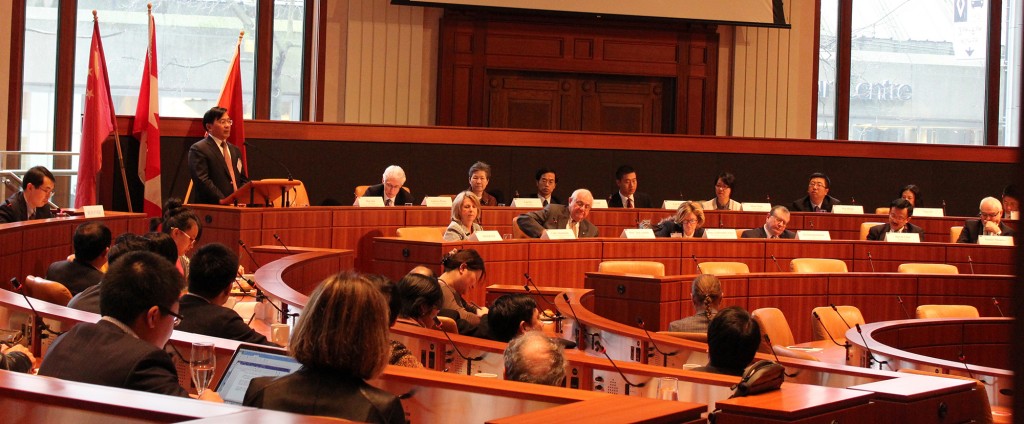Beedie hosts historic presentation on China’s 13th Five-Year Plan
Jan 19, 2016
Mr. Han Jun, Vice Chairman of China’s Office of the Central Leading Group on Financial and Economic Affairs and Central Rural Work Leading Group, spoke about China’s thirteenth Five-Year Plan at a special event hosted by the Jack Austin Centre for Asia Pacific Business Studies at SFU’s Beedie School of Business.
A commitment to innovation and green technologies, and a shift away from the inefficient economic model that relies on cheap labour for manufacturing will play fundamental roles in the future of China’s economy.
These were some of the revelations at a historic special presentation from Mr. Han Jun, Vice Chairman of China’s Office of the Central Leading Group on Financial and Economic Affairs and Central Rural Work Leading Group, at a special event hosted by the Jack Austin Centre for Asia Pacific Business Studies at SFU’s Beedie School of Business on January 15 at the Wosk Centre for Dialogue in downtown Vancouver.
In the presentation, Han offered details on China’s thirteenth Five-Year Plan, a national strategy set by the country’s top leaders. The Five-Year Plan sets out China’s policies for social development and economic growth, identifies promising areas for investment, and indicates where governmental resources will be concentrated.
Han noted that between 2009 and 2014 the average annual growth of China’s economy was 8.7 percent, which compared extremely favourably to the global average of two percent during this period. While this growth had slowed in 2015, China’s economy still grew 6.9 percent, making them one of the fastest growing economies in the world, boasting the second highest GDP in the world of USD $10.2 trillion.
In response to media reports that the slowdown in China’s economy is indicative of an impending crisis, Han said that any country with such a large economy would inevitably experience slowdown in growth eventually. This did not worry the Chinese government, and they had set a goal for the next five years of an average annual GDP growth during this period of over 6.5 percent – which would potentially see China overtake the US as the world’s largest economy.
Han also noted statistics supplied by various think tanks, including that China now has more middle class citizens than that of the US – approximately 100 million – and that the total financial assets of Chinese households in 2014 amounts to USD $15.6 trillion – equivalent to 41.7 percent of the whole of Asia. He said that these figures indicated there is still a large amount of domestic consumption and investment in China that will inject strong dynamism to grow investment and development in China.
Moving on to the development of the Five-Year Plan, Han said that the decision makers did not give priority to the speed of the economic growth but instead to the transformation of the model of economic growth.
“The previous economic development model in China relied on exports, but last year the trade of export goods only grew by 1.8 percent,” he said. “The previous model also relied on cheap labour, which is an inefficient model of growth. We must transform the model of economic growth to one relying more on domestic demand and also innovation. We will pursue a higher quality and sustainable growth.”
To realize China’s plan for economic growth, the Five-Year Plan focuses on five key adjectives: innovation, coordinated, green, open, and inclusive. Han described these keywords as an “integrative development strategy and concept”, and noted that the core of the plan is innovation, with a purpose of shared, inclusive development.
“In terms of innovation, the goal is clear,” he said. “In the past 30 years in many areas we are trying to catch up. In future, in more areas we will try to become a parallel runner, or in some fields we will work hard to become a front-runner.”
Han also spoke of green development being an important internal requirement of the plan, citing the recent commitment China had made to reduce its CO2 emission by 60 to 65 percent by 2030.
“I believe the most important part of the plan is green development – there will be a huge amount in China for green development, low carbon technologies, and circular technologies,” he said. “”I know Canada has good experience and good technological edge in tackling pollution and sustainable development. There is great potential for cooperation between our two countries in these fields.”
Noting that China ranks as the third largest outbound investor to other countries in the world – spending USD $123.4 billion in 2014 – Han stated that China was more than just a source of low cost commodities, but rather, an important figure in outbound investment.
In order to successfully implement the Five-Year Plan, China must deepen reforms, Han said – a process in which they are already deeply committed. China has paid a big price for its stock market fluctuations recently, but through this they learned much, in particular that the stock market lacked maturity in many related areas.
Contrary to what the media has reported, however, the difficulties in the stock market do not mean that the Chinese economy is in crisis. The total number of listed companies in China is equal to only 30 percent of the country’s GDP, whereas in the US it is over 100 percent. As such, it is incorrect to measure the economy in China by the stock market’s success. In spite of this, Han said that China is sorely aware that it needs to improve the financial regulatory system, and will release important measures to do so in the future.
“Over the past 37 years, the top leaders in China have led the Chinese people with great vision to walk towards the world.” Han said. “The Chinese economy has been fully integrated with the global economy. We are full of confidence of making a successful transformation of China’s economy.”
View the full presentation below:
About Ross MacDonald-Allan
Twitter •